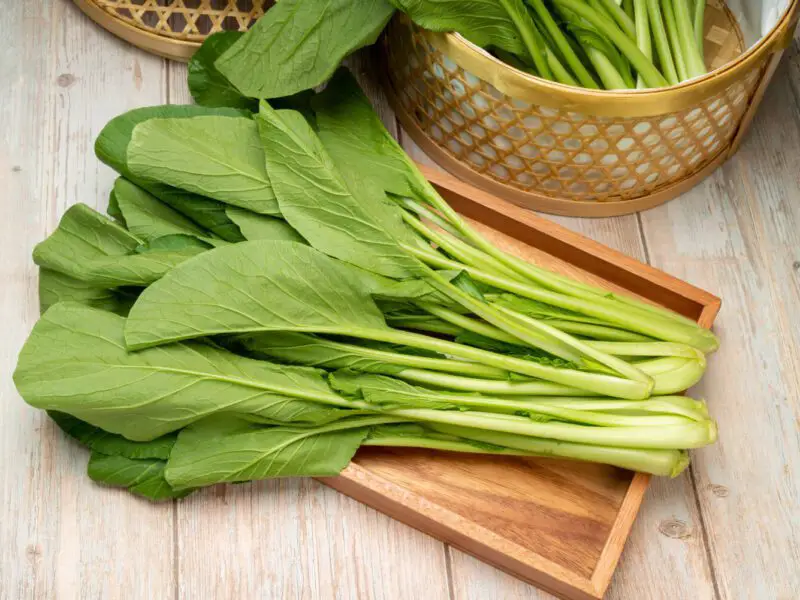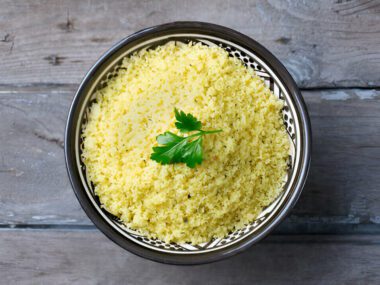Ever found yourself staring blankly at those vibrant green veggies in the grocery aisle, wondering whether you’re looking at yu choy or choy sum? Don’t worry, you’re not alone! These two Chinese greens may seem like identical twins, but there are actually some key differences that set them apart.
If you’re a fan of Asian cuisine or just love experimenting with new veggies, you’ll want to know exactly what you’re tossing in the wok. Are the stems thin and tender or a little thicker and fibrous? Are the leaves bright green or edging towards bitter as they mature? Is it better for stir-fries or does it need some extra cooking time?
Knowing the difference between yu choy and choy sum can mean the difference between a successful veggie stir-fry and a sad, overcooked mess. But no need to panic – we’re diving deep into what makes each of these leafy greens unique. Get ready to become a yu choy and choy sum expert!
What is Yu Choy?
Yu choy, also known as yu choy sum or yu choy greens, is a variety of Chinese flowering cabbage. It’s a member of the brassica family, closely related to vegetables like broccoli, cauliflower, and Brussels sprouts.
The name “yu choy” literally translates to “oil vegetable” in Cantonese. This refers to the fact that the seeds of mature yu choy plants can be pressed to produce a flavorful cooking oil.
Yu choy has thick, flat green stems and large, oval-shaped dark green leaves. As the plant matures, the stems become tougher and more fibrous. The leaves also develop a slightly bitter flavor over time.
One of the most distinctive features of yu choy is the bright yellow flowering buds that appear at the tops of the stems. These edible flowers have a delicate, peppery taste.
In Cantonese cuisine, yu choy is a popular green vegetable used in stir-fries, soups, and dim sum dishes like cheung fun (rice noodle rolls). The stems, leaves, and flowers are all edible and nutritious parts of the plant.
What is Choy Sum?
Choy sum, also known as Chinese flowering cabbage, is a leafy green vegetable closely related to yu choy. It’s a member of the brassica family, along with vegetables like bok choy, broccoli, and cabbage.
The name “choy sum” translates to “vegetable heart” or “flowering cabbage” in Cantonese. This refers to the edible yellow flowering buds that sprout from the tops of the stems.
Choy sum has slender, crunchy green or white stems with oval-shaped green leaves. The leaves have a slight mustard-like flavor that becomes more bitter as the plant matures.
Unlike the thicker, fibrous stems of mature yu choy, choy sum stems tend to stay tender and crisp even when the plant is older. This makes choy sum preferable for quick-cooked dishes like stir-fries.
In Chinese and other Asian cuisines, choy sum is popular for its versatility. The stems, leaves, and yellow flowers can all be eaten and added to dishes like soups, dim sum, and vegetable stir-fries. It has a mild, fresh, slightly peppery flavor.
Choy sum is also nutrient-dense, providing good amounts of vitamins A and C, as well as calcium, iron and other minerals.
The Difference Between Yu Choy and Choy Sum
While yu choy and choy sum may seem virtually identical at first glance, there are some distinct differences that set these two Chinese greens apart. Understanding the variations can help you choose the best one for your dish and prepare it properly.
Maturity
One of the primary distinctions is the maturity level. Choy sum generally refers to the younger, more tender plants with slender, crisp stems and leaves that have a mild, mustardy flavor. Yu choy, on the other hand, describes the mature version with thicker, fibrous stems and leaves that develop a slightly bitter taste over time.
Stems
The stems are a key differentiator. Choy sum stems are thin, cylindrical, and stay crisp and crunchy even as the plant ages. Yu choy stems are thicker, flatter, and become tough and stringy when mature. Choy sum stems can be green or white, while yu choy stems are consistently green.
Leaves
Both have flat, oval-shaped green leaves, but yu choy leaves tend to be larger and develop a more pronounced bitter flavor the older the plant gets. Choy sum leaves are smaller and retain a milder mustardy taste even when mature.
Flowers
The vibrant yellow flowering buds found on both plants are edible. But choy sum tends to produce more abundant flower clusters compared to the sparser blooms on yu choy.
Size
Choy sum plants are generally smaller overall when harvested for eating, while yu choy is allowed to grow larger before harvesting its tougher, more mature stems and leaves.
Uses
Due to its tender texture, choy sum is ideal for quick-cooking methods like stir-fries or fast sautés. The crunchy stems can even be enjoyed raw in salads. Yu choy’s tougher, more fibrous structure means it benefits from longer cook times like braising or additions to soups and stews.
More Details on Choy Sum
Now that we’ve covered the key differences between choy sum and yu choy, let’s dive deeper into the details about this tender, versatile veggie.
Cultivation
Choy sum is cultivated specifically for its edible stems, leaves, and abundant flowering shoots. It grows rapidly, with plants typically being harvested for consumption around 30-60 days after planting when they are still young and tender.
The white-stemmed variety is more cold-hardy, while the green-stemmed type prefers warmer temperatures. Both thrive in well-drained soil with plenty of moisture.
Flavor Profile
Choy sum has a distinctive flavor that combines mild mustard notes with a subtle pepperiness and delicate sweetness. The leaves tend to taste the most pungent, while the stems are crisp and juicy with just a hint of bitterness.
The flowering buds have a more concentrated mustard-peppery punch that adds a flavor accent when incorporated into dishes.
Changes with Age
One of the benefits of choy sum is that it retains its tender texture and fresh, mild taste even as it matures, unlike some other leafy greens that become unpleasantly bitter or tough.
While the leaves will develop a slightly more assertive mustardy bite over time, the stems of choy sum stay crisp and juicy rather than becoming fibrous and woody like mature yu choy stems.
Varieties
There are two main variety types of choy sum:
Green Choy Sum – Features slender green stems and green leaves. More heat tolerant.
White Choy Sum – Has pale white or light green stems similar to bok choy, with green leaves. Does better in cooler temps.
Both share the trademark bright yellow flowering buds.
Nutritional Benefits
Choy sum is a nutritional powerhouse packed with vitamins and minerals. It’s an excellent source of vitamins A and C, as well as a good source of calcium, iron, and potassium.
The leafy greens also provide folate, vitamin K, and antioxidants like vitamin E and glutathione. All around, it’s one of the more nutrient-dense greens you can add to your diet.
So whether you’re stir-frying, blanching, or using choy sum fresh in salads, you’ll be getting a big nutritional boost along with its unique, delicious flavor.
FAQs
What’s the difference between yu choy and choy sum?
The main differences are that choy sum refers to the younger, more tender plants with slender crisp stems, while yu choy refers to the mature plants with thicker, fibrous stems. Choy sum also has smaller leaves with a milder mustard flavor compared to yu choy’s larger, more bitter leaves.
Can I use yu choy and choy sum interchangeably in recipes?
While they are closely related, it’s best to use them for the intended purposes based on texture and flavor. Substitute tender choy sum for quick-cooked dishes like stir-fries, and use hardier yu choy for longer braises or soups where it can tenderize.
Are the yellow flowers on choy sum and yu choy edible?
Yes! The vibrant yellow flowering buds are not only edible but also a delicious part of the plant with a peppery mustard flavor.
How do I store choy sum/yu choy?
Wrap them in a damp paper towel and store in a reusable plastic bag in the crisper drawer of your fridge for up to 5 days. Don’t wash until ready to use.
What dishes can I make with choy sum/yu choy?
Both greens are versatile in Asian cuisines like Cantonese, used in stir-fries, soups, dim sum items, and more. Choy sum also works well in salads or just quickly blanched. Yu choy holds up to longer cooking like braising.
Do choy sum and yu choy need to be cooked?
No, you can enjoy both vegetables raw when young and tender by adding them to salads. But cooking helps mellow any bitterness.
Final Words
Whether you’re a seasoned lover of Chinese greens or just discovering the joys of yu choy and choy sum, understanding their distinct differences is key to unlocking their full flavors and textures.
From the tender crunch of young choy sum to the earthy bitterness of mature yu choy leaves, each veggie brings its own unique characteristics to Asian dishes like stir-fries, soups, and dim sum favorites.
Don’t be intimidated by their similar appearances – take the time to appreciate their nuances. The slender stems of choy sum are perfect for quick cooking methods that preserve their juicy snap. While yu choy’s hardy structure means it can stand up to lengthier braises and simmering to become deliciously tender.
And of course, don’t forget the edible flower buds crowning both plants – a delightfully peppery garnish to add a flavor punch.
With a little knowledge under your belt, you’ll be chefsumming and yu choying like a pro, seamlessly incorporating these flavorful greens into your meals. Who knows, you may even convert some picky eaters with their fresh, vibrant tastes.
So next time you’re wandering the Asian supermarket aisles, give a nod of appreciation to these two veggie cousins. They may share roots, but yu choy and choy sum are each wonderfully unique in their own ways.



